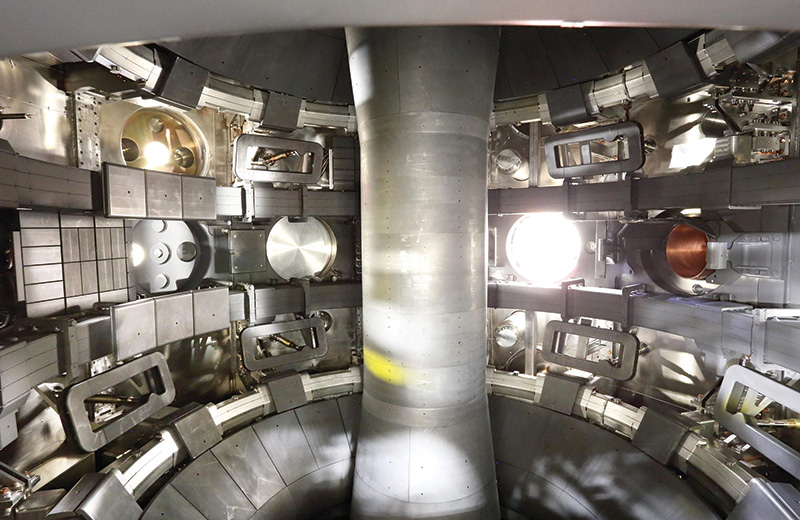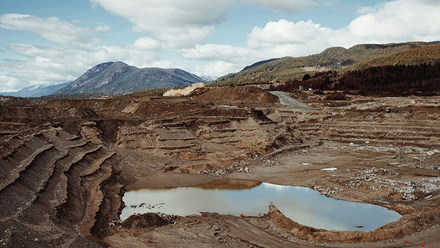Force of nature - fusion for the future?
Can the long-awaited and seemingly science fiction of nuclear fusion ever become a commercial reality? Alex Brinded reports.

It was timely that the fusion brief first came across my desk as the film Oppenheimer hit cinemas worldwide. A film about how nuclear fission was exploited to develop the atomic bomb, it deals with how incredible minds and great ambition can break scientific boundaries, although in this case with ensuing disastrous consequences.
By 1951, methods were found to control nuclear fission reactions to start producing power, yet nuclear fusion energy has still remained a dream for physicists for nearly 80 years.
A universal challenge
Fusion involves mixing two forms of hydrogen and heating them to extreme temperatures, causing them to combine and release energy, which is then harnessed to generate electricity.
I recall distinctly the moment when, at school in the 90s, my Physics’ teacher’s eyes lit up when talking about the possibilities of nuclear fusion. It may never happen, he said, but it is a physicist’s dream. For the first time ever, humans would get more energy out than they put in, he shared. 'Think about that, infinite energy like the sun.'
UK Atomic Energy Authority (UKAEA) Director, Professor Sir Ian Chapman, referenced Stephen Hawking’s last ever book at a Westminster Forum event earlier this year on 'Priorities for developing the fusion industry in the UK'.
Hawking was asked what world-changing idea he would like to see implemented. 'This is easy,' Hawking is quoted as saying, 'the development of fusion power to give an unlimited supply of clean energy, and a switch to electric cars. Nuclear fusion would become a practical power source and would provide us with an inexhaustible supply of energy, without pollution or global warming'.
As Chapman echoed at the conference, fusion is a challenge with enormous benefits. 'You cannot have a runaway event like you can have with fission. Physics tells you that’s impossible. [Also] if we can make it work, it will be reliable. You don’t wait for the wind to blow and the sun to shine. It’s sustainable in that our raw fuel is lithium, and we have plenty of lithium and seawater. And it’s also incredibly energy dense, in fact, the most energy dense thing that you can do on Earth.'
The main reason it is so hard to do, says Chapman, is because the fuel must be about 10 times hotter than the centre of the sun. The sun has an enormous gravitational mass that forces the hydrogen and helium close enough to fuse, and so because we cannot recreate that mass on earth, we have to make the fuel even hotter. A big challenge among many.
The UK Government’s 2021 fusion strategy has two clear goals, pointed out Chapman – to build a prototype to demonstrate the delivery of electricity to the grid, and to establish an industry to export and sell fusion. 'That is really important to me,' he said. 'We cannot tackle climate change unless we think of it as a global problem. There is no point in thinking about parochial UK energy policy…You need solutions that work in all jurisdictions and fusion would be one of those.'
That dream is finally beginning to crystallise, with milestones being achieved in major fusion projects around the world.
A global outlook
The International Atomic Energy Agency released its first World Fusion Outlook in October 2023. The report explores how fusion could be part of the
long-term plan for net-zero and climate change mitigation by satisfying rising electricity demands.
“Advances made in various disciplines, from physics and computational science to engineering and material science and qualification of components, are steadily transitioning fusion energy from vision to reality,” says the Director General Rafael Mariano Grossi.
The report notes the recent scientific and technology breakthroughs, and a significant increase of activities and investments in the private sector – with 43 private sector companies globally and US$6.2bln invested in fusion companies.
The report notes that 19 of 30 companies surveyed by the Fusion Industry Association in 2023 said they expect it to be on the grid by 2035.
Notable developments worldwide include:
- The formation of Industrial Fusion Solutions Ltd in the UK as a new delivery body for the national fusion programme. In September 2023, it announced plans to invest up to £650mln by 2027 and was the first to propose fusion-specific regulation, outside of nuclear licensing requirements.
- Japan has formed a Fusion Industry Council and first plasma operations began at the end of 2023 on the Japan Torus-60 Super Advanced tokamak, a European-Japanese project claimed as the most powerful experimental fusion device to date.
- In March 2022, the US launched three new initiatives following its summit on ‘Developing a Bold Decadal Vision for Commercial Fusion Energy’.
- In March 2023, the European Commission’s Net-Zero Industry Act specifically listed fusion energy as a target of investment.
- Germany has announced more than €1bln investment over the next five years.
Building the infrastructure
The Culham Centre for Fusion Energy in Oxfordshire, UK, is where the Joint European Taurus (JET) project lives – the world’s largest and most advanced tokamak, according to the UKAEA. The Mega Amp Spherical Tokamak (MAST) Upgrade is also at this hub – a next generation to the original MAST machine that focuses on plasma exhaust and how to extract heat.
The site in Culham is large. Large enough that it requires a car to travel between the different parts of the building. When I visited the Materials Research Facility onsite, it had recently been extended to more than double in size to analyse material properties in support of fusion research.
Timing was crucial as I happened to arrive just before a high-security alarm test where access becomes difficult. Active Materials Testing Lead Dr Andy London was good enough to show me their work, including the mechanical robots they use to manipulate materials inside secure, metal-lined boxes, similar to a giant arcade claw game.
He explained, 'The three big materials challenges we are tackling as a business unit…is the neutron displacement damage, the transmutation – which physically changes the identity of the different elements in your material, then there’s the tritium. Now, tritium is critical for fusion fuel [but] it’s also radioactive.
'To be able to operate safely, we need to make sure we are not discharging the tritium to the atmosphere…Within the reactor itself, we need to make sure we are containing the tritium...to balance the plant.
'The challenge is twofold. One is stopping the tritium getting into the [reactor infrastructure] in the first place. And the second is getting the tritium out of the material as well. In a breeder blanket, which is where you are producing the tritium from lithium, you have to have ways of getting the tritium out efficiently. Otherwise, you are creating all this tritium but not using it.
'We are basically isotopically tailoring material in order to produce something that is ultimately less radioactive once the fusion reactor stops operating. We have to do a lot of upfront thought about what materials we can use. And then taking that limited power to different compositions, and then tailoring it with thermal mechanical treatments, in order to optimise our steel to make it, stronger, more tough, durable. And one of the leading candidate ways of doing that is by introducing very small, stable carbide precipitates.'
Meanwhile in Yorkshire, the UKAEA is building a facility to test components on a larger scale of 2m x 1m, under the combined loads present in fusion power plants. They are also building, what Chapman suggests, will be one of the largest tritium research facilities – H3AT (Hydrogen-3 Advanced Technology). He notes that they have 400 roboticists working on solutions for fusion power plants.
Strategy thinking
On 8 November 2023, the UK and US announced a new strategic partnership to develop fusion technology. It will bring together scientists and engineers to address the technical challenges of delivering commercially viable fusion energy, allow shared access to facilities, standardise international regulatory frameworks and codes of practice, seek to develop resilient supply chains for fusion materials, and promote skills development.
Forging links between the MAST-U tokamak in Oxfordshire and the DIII-D tokamak in California could propel this energy force further given breakthroughs in research at both ends. This time last year, the US National Ignition Facility (NIF) at Lawrence Livermore National Facility in California reported a major milestone – they achieved fusion ignition with more thermal energy produced in their experiments than was put in. A feat that was repeated in summer 2023. And earlier in 2022, the UK reported a 'world record' for fusion energy producing 59MJ, 'maybe enough to drive an electric car from London to Birmingham', reflected Chapman.
The NIF squeezes together the world’s most energetic laser, which then becomes 100 times denser than lead at a temperature of 100mln°C.

Based on this breakthrough, Longview Fusion Energy Systems Inc, spearheaded by the team from the NIF, has plans to build the world’s first laser fusion power plant. This will aim to combine the NIF’s laser fusion breakthrough with modern, efficient lasers and a patented design to replicate these conditions several hundred times a minute – similar to the repetitive pulses in a car engine but delivering over one million horsepower.
'The Longview power plant is based on the world’s only experimental demonstration of fusion burn,' says Valerie Roberts, who led the delivery of the NIF fusion facility with Dr Edward Moses. 'It can use materials and products available today, cutting decades off the commercialisation process.'
Jeremy Chittenden, Professor of Plasma Physics and Co-Director of the Centre for Inertial Fusion Studies at Imperial College London, UK, described the NIF at the Westminster event as being the size of three football fields, and a US$4bln facility with the largest generator in the world.
He explained that, unlike a tokamak, ignition tries to reproduce the pressure of the sun, as well as the temperature. This requires the fuel to be compressed to an extremely high density, using either magnets or laser, producing a plasma that creates alpha particles and energy. And the whole process tries to amplify the energy, so it is recycled to heat the fuel further. The NIF facility managed to achieve that heat recovery in 2021, before their breakthrough in December 2022.
Chittenden noted they are actually replicating a process that is more like what is happening in supernova explosions, 'a state of matter that we haven’t seen in the Universe since the first few minutes after the Big Bang, which allows us to use this for all sorts of interesting fundamental science challenges, such as what controls the abundance of different isotopes in the Universe'.
With the US’ plans to build the world’s first laser fusion power plant, it has also published its decadal vision for fusion with public-private partnerships that essentially double the money of a private investor, Chapman observed.
Pumping in investment
Meanwhile, the €20bln-plus International Thermonuclear Experimental Reactor (ITER) in France is about 80% built, said Chapman. JET requires 1GW to operate, with plans to produce 10MW. So, despite breaking the world record last year, it consumes more energy than it produces for now.
The ITER Tokamak project is another step up. Chapman described the European project as 'the largest scientific collaboration ever undertaken by humanity', with the aim to put 50MW in to heat the fuel and make it fuse and produce 500MW. 'That will be a major step in our field. And as well as that really exciting research goal, it’s also establishing a global supply chain, which just didn’t exist before.' The building is 80m x 120m x 80m, which is on the scale of Wembley stadium in London.
'Geopolitically it is a nightmare,' Chapman said, as China, the US and Russia are still working together with the EU on this project. 'I am actually amazed that the project is still going, but it is.'
It has the largest AC-DC distribution centre in Europe, the largest cryogenics plant in the world, and 'it is just a phenomenal piece of engineering”, he enthused. 'ITER has the biggest magnet ever made, which produces a magnetic impulse equivalent to the weight of an aircraft carrier'.
The challenge is identifying how the very high flux of high energy neutrons affects the plant walls, as each neutron causes a displacement that can become a cascade or propagate other dislocations, swelling and cracking.
However, they have no way of replicating the conditions of a fusion plant until they have built a fusion plant. This all means there is uncertainty over how long these components will actually last.
They are also still struggling to deal with the extreme heat, which is 150mln°C in the middle of the tokamak – 10x the temperature of the sun’s core.
DEMO is EUROfusion’s successor to ITER and will be the final stage of its roadmap to take fusion energy from a science-driven, lab-based exercise to an industry- and technology-driven programme. The designers anticipate 300-500MW net electricity delivered to the grid and to operate with a closed fuel-cycle, meaning spent tritium fuel will be reprocessed.
But going back to ITER, it is incredibly expensive, Chapman noted, and so in parallel they have to consider how to drive down the cost of building future power plants.
The spherical tokamak concept that is being developed in the UK, he explained, is a compact fusion machine, “which allows you to strip out billions, literally billions, from the overnight costs', by using smaller magnets.
But using a smaller containment for the heat source increases the chances of melting the walls, which is what the MAST Upgrade is intending to solve. It won the UK Royal Academy of Engineering Major Project Award 2021, 'because it is the most complicated piece of engineering the country has done', reflected Chapman.
The new design was meant to reduce the heat by a factor of 10, which Chapman acknowledged was 'a pretty bold claim'. Building it was 'phenomenally difficult', and they got the first results 18 months ago. 'If you want to see experiments match modelling, frankly, you could do a lot worse than this…It really can reduce
the heat that gets to the walls, and that is transformative.'
The prototype the UK Government is investing in is based on this compact power plant design and called the Spherical Tokamak for Energy Production (STEP). It aims to produce net electricity for the grid, at a lower capital cost than alternative approaches like ITER. So far, the government has invested nearly £250mln into the concept design phase, which is on track to finish in 2024, with plans to complete the actual building in 2040.
Chapman thinks the UK has all the ingredients to make this work. 'We have the largest fusion organisation on the planet. We have a breadth of capability you can’t find anywhere else. We have a burgeoning private industry with lots of the biggest fusion companies in the world here in the UK. And we have a brilliant academic sector.'
He reported a huge amount of investment coming into private fusion in the UK, with about £5bln invested, half of which was in the preceding 12 months alone at the time of writing. There are 40 companies hosted at the Culham site, with that number continuing to rise.
'And to cement that position, which is utterly disproportionate to the size of…the UK’s energy market, we need to keep investing and keep that lead.'
The dream of many
Also speaking at the Westminster event, Dr Simon Barber, Managing Director at Assystem, noted that, ultimately, to fulfil the dream of many 'fusion has and always will continue to be centred around international collaboration. In fact, the sector today is geared on information and knowledge sharing, about looking at the various experiments that are in operation around the globe and sharing intelligence insights to enable the growth of the sector'.
Chittenden concurred, 'The different types (of fusion technologies) are very key to funding diverse research activities. Because we can’t back just one or two horses in this race. We need a Manhattan approach [diverse R&D programme to develop nuclear weapons during World War II], where we try all approaches simultaneously. Because otherwise, we are not going to have any contribution to climate change in the 50-year timescale.'
Growing the fusion workforce
The UK’s Fusion Cluster has launched a report that sheds light on the key challenges the UK fusion energy industry faces as it seeks to expand its workforce and augment it with new skills to catalyse the transition from research to the delivery of commercial power plants.
Titled Growing the fusion workforce: challenges and opportunities for the future, the study is a review of the skills landscape undertaken by a consortium of companies, suppliers, recruiters and training providers.
The report’s findings will help to realise the UK Government’s plan to invest £56mln in a fusion skills programme.
The key findings are that the fusion workforce requirements are inextricably linked with technological progress and investment, requiring a focus on skills, rather than job roles, to allow fusion to draw from a wider range of potential recruits in other sectors.
A targeted communications plan is essential to entice potential recruits, highlighting the rapid progress that is being made, routes into fusion and structured career pathways.
Apprenticeship programmes were also flagged as crucial for 'ushering in a new generation of people into fusion', but these must be timed to ensure that there is sufficient work available at the end.
Valerie Jamieson, Development Manager for The Fusion Cluster, says, ''Delivering fusion energy will require expertise from a wide range of people and industries. This workforce report sets out some of the issues the fusion sector needs to consider to realise its ambitions to provide the sustainable power the world needs. While we don’t have all the answers yet, it starts the right conversations we need to have.'







